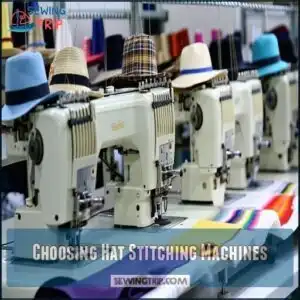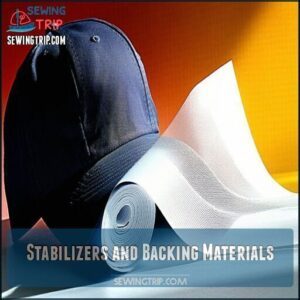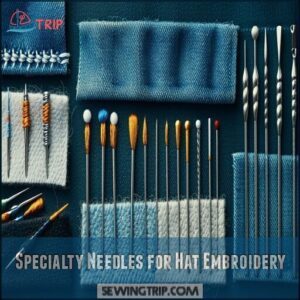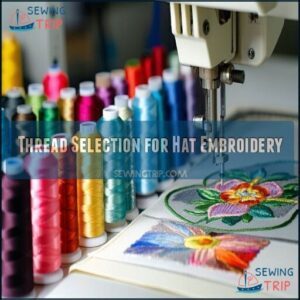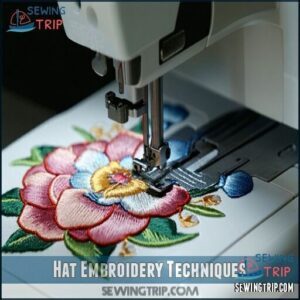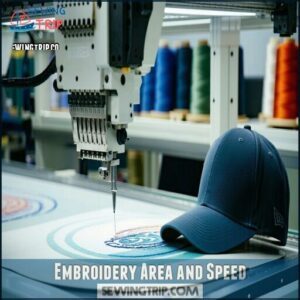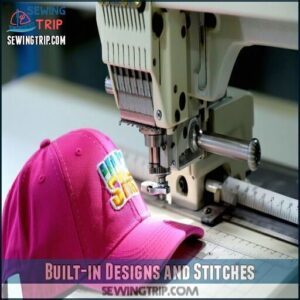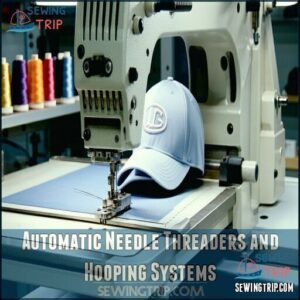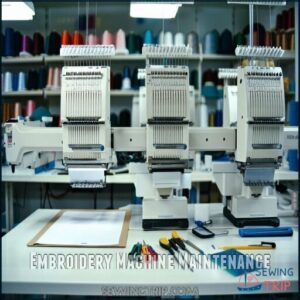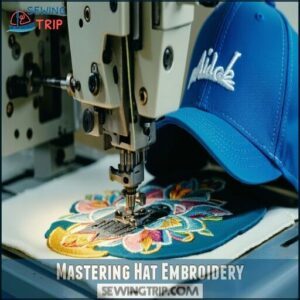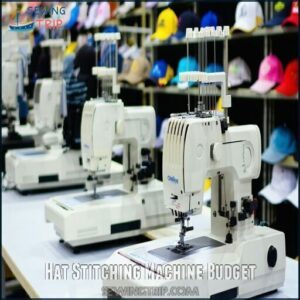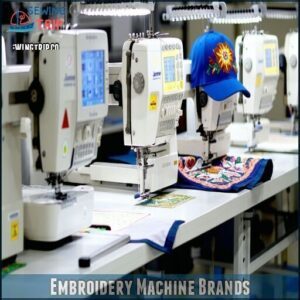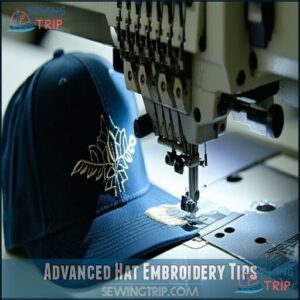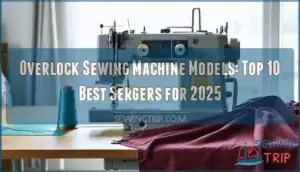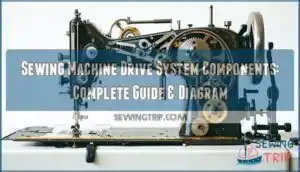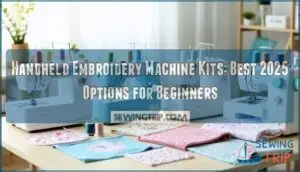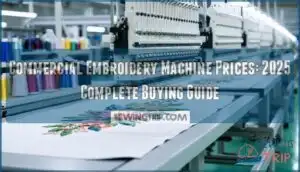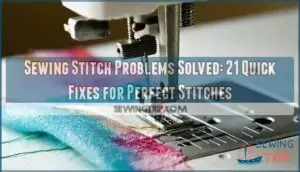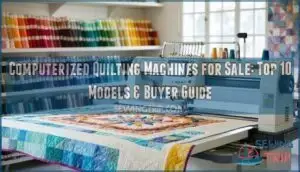This site is supported by our readers. We may earn a commission, at no cost to you, if you purchase through links.
 Finding the perfect hat stitching machine depends on your needs, but these top five options cover all bases.
Finding the perfect hat stitching machine depends on your needs, but these top five options cover all bases.
The Brother PE800 stands out for its user-friendly interface and 5"x7" embroidery area, perfect for clean designs.
The Janome’s MB-4S, a four-needle powerhouse, handles commercial embroidery with speed and precision.
The versatile SINGER Legacy SE300 combines sewing and embroidery in one sleek machine. The reliable Janome MC 9500 balances creative flexibility with robust features.
For serious professionals, the Smartstitch S1201 offers commercial-grade performance in a compact size. Ready to discover which machine best fits your style and stitching ambitions? Keep reading to find the perfect match for your needs, with options that offer user-friendly interface.
Table Of Contents
- Key Takeaways
- Choosing Hat Stitching Machines
- Essential Embroidery Accessories
- Hat Embroidery Techniques
- Machine Features and Specifications
- Embroidery Machine Maintenance
- Mastering Hat Embroidery
- Top 11 Hat Stitching Machines
- 1. Brother PE800 Embroidery Machine
- 2. Janome Memory Craft MC 9500 Sewing Machine
- 3. SINGER Legacy SE300 Embroidery Sewing Machine
- 4. Janome MB-4S Four Needle Embroidery Machine
- 5. Smartstitch S1201 Compact Commercial Embroidery Machine
- 6. BAI Mirror Embroidery Machine 20×14 15 Needle
- 7. Smartstitch S1501 Commercial Embroidery Machine
- 8. CAMFive EMB HT1501 Commercial Embroidery Machine
- 9. Brother PE770 5×7 Embroidery Machine with USB
- 10. Sulky Totally Stable White Fabric
- 11. Dritz Disappearing Ink Marking Pen
- Hat Stitching Machine Budget
- Embroidery Machine Brands
- Advanced Hat Embroidery Tips
- Frequently Asked Questions (FAQs)
- Conclusion
Key Takeaways
- When picking a hat stitching machine, focus on needle count, embroidery field size, and speed to match your specific projects.
- The Brother PE800 is great for beginners with its user-friendly design, while machines like the Janome MB-4S or Smartstitch S1201 suit professionals with commercial needs.
- Accessories like stabilizers, specialty needles, and quality threads are essential for smooth stitching and durable designs.
- Regular maintenance will keep your machine running efficiently and prevent issues.
Choosing Hat Stitching Machines
You’ll need to keep in mind key features like needle count, embroidery field size, and stitch speed when selecting a hat stitching machine for your projects.
Needle count, field size, and stitch speed are the keys to finding the perfect hat stitching machine for your needs.
Your budget and intended use, whether for home crafting or commercial production, will determine which of the 2025 models offers the best combination of performance and value.
Researching Embroidery Machines
Research is your compass when exploring the domain of hat embroidery machines.
Before making a purchase, follow these four essential steps:
- Compare machine specifications across brands
- Read user reviews on specialized forums
- Watch YouTube demonstrations of hat stitching equipment
- Analyze feature-to-price ratios
Don’t rush this process—thorough research prevents costly mistakes and guarantees you find the best hat machine for your specific needs, which is crucial for a successful outcome with hat embroidery machines.
Considering Budget and Needs
Your budget creates the boundaries for your hat embroidery machine search.
Before opening your wallet, assess whether you need a single-needle Brother PE800 for occasional projects or a commercial 15-needle powerhouse for business scalability.
Match features to your skill level and project complexity.
The best hat machine for beginners might lack the advanced capabilities professional embroiderers require.
Hat stitching equipment prices range dramatically based on speed, capacity, and automation.
Some users prefer machines with cylindrical or tubular designs for hat projects, considering factors like project complexity and their own skill level.
Evaluating Brand Reputation
When choosing a hat stitching machine, it’s smart to look at brand reputation. Reliable embroidery machine brands often have strong customer reviews and market share.
Examine the backstory of hat machine brands—ethics, quality, and innovation matter. Social media insights also help. After all, trusted brands deliver consistency.
- High-quality products
- Consistent performance
- Excellent customer reviews
- Ethical practices
- Strong market share
Essential Embroidery Accessories
To achieve flawless hat embroidery, you’ll need the right accessories to complement your machine.
Stabilizers, specialty needles, and quality threads are essential for maintaining precision and durability in every design.
Stabilizers and Backing Materials
Backing and stabilizers will make or break your hat embroidery projects.
Tear-away and cut-away stabilizers each suit different designs—tear-away is great for light fabrics, while cut-away adds durability.
Adhesive backing works wonders on tricky curves.
Selecting the right hat embroidery stabilizer is essential for professional results.
Check the table below for quick guidance:
| Stabilizer Type | Best For | Backing Weight Options |
|---|---|---|
| Tear-Away | Light Designs | Lightweight to Medium |
| Cut-Away | Dense Designs | Medium to Heavy |
| Adhesive Backing | Hats with Curves | Permanent or Temporary |
The choice of stabilizer significantly affects the outcome, and using the right type can make a huge difference in the quality of your embroidery.
Specialty Needles for Hat Embroidery
In the context of hat embroidery, the right needle changes everything.
Use sharp embroidery machine needles designed for thicker fabrics to prevent breaks and guarantee smooth stitching. Choosing the correct needle size, suited to your fabric compatibility, maintains proper thread tension.
Many embroiderers find that they need to stock up on various needle types for different projects.
Specialty hat embroidery needles handle curves effortlessly, making your project seamless, even on challenging designs or materials, which is why having the correct needle is crucial for a smooth stitching experience.
Thread Selection for Hat Embroidery
For flawless hat embroidery, pick embroidery thread that matches your design needs.
Thread weight affects detail; a finer weight suits intricate patterns.
Fiber type, like polyester, boosts durability and minimizes thread breaks.
Verify color fastness for bold, lasting designs on hats.
For those seeking supplies, consider specialized hat embroidery for superior results.
Specialty threads, such as metallics, add flair, but adjust thread tension on your hat embroidery machine to prevent snags, ensuring superior results and durable embroidery.
Hat Embroidery Techniques
Mastering hat embroidery techniques guarantees your designs come out crisp, durable, and professional-looking.
Crisp, durable, professional designs start with the right tools and techniques—unlock flawless results with precision hat embroidery.
You’ll need to focus on precise hooping, proper tension adjustments, and effective digitizing to achieve the best results.
Proper Hooping Techniques for Hats
Hooping hats can be tricky due to curved surfaces. Start with the right hat hoops or embroidery hoops designed for hats.
Use firm hat stabilizers to anchor the fabric securely, and guarantee even tension adjustment to avoid distortion.
Proper alignment is key—double-check placement before stitching. A well-hooped hat guarantees your hat embroidery machine delivers crisp, professional results every time.
Adjusting Tension for Different Hat Materials
Adjusting tension for different hat materials is key to perfecting embroidery.
A material tension guide helps match tension to fabric type, avoiding puckering or loose stitches. Balance stabilizer tension for clean results.
Test thread type and needle size effects on sample fabric first to avoid troubleshooting tension issues later.
- Match tension with material.
- Use proper stabilizer balance.
- Test tension on scraps.
Thread tension adjustments keep your hat embroidery flawless.
Digitizing Designs for Hat Embroidery
When perfecting custom hat embroidery, digitizing software is your go-to tool.
Focus on file formats compatible with your hat embroidery machine. Adjust stitch density to match design complexity, ensuring clean results.
Use hat templates in embroidery software for precise placement. The right hat digitizing software bridges your creativity with flawless execution, transforming ideas into pro-level designs effortlessly.
Machine Features and Specifications
When choosing a hat stitching machine, it’s essential to focus on features like embroidery area, speed, and built-in designs that match your needs.
Look for options with automatic needle threaders and efficient hooping systems to keep your workflow smooth and hassle-free.
Embroidery Area and Speed
When selecting a hat embroidery machine, consider how embroidery area and speed impact production volume.
Larger design sizes demand hoop compatibility, while machines with high stitch speeds improve efficiency.
Hat hoops should accommodate curved surfaces, ensuring precision stitching. A machine with adjustable embroidery areas is ideal for versatile projects, letting you create intricate designs faster, boosting overall output and machine efficiency.
Built-in Designs and Stitches
Having a wide range of built-in designs and embroidery fonts makes stitching hats easier and more creative.
Machines with high memory capacity let you store decorative stitches and hat embroidery designs for quick access.
Look for models offering stitch customization and design editing directly on the screen, as design variety guarantees every project feels unique and professional, with the ability to make each one truly creative.
Automatic Needle Threaders and Hooping Systems
Threading your machine can feel like threading a needle in the dark—unless you’ve got an automatic needle threader.
These clever systems save time and frustration.
Pair it with a hat embroidery frame and precise tensioning system accuracy, and you’re ready for flawless stitching.
Hat hoops and adjustable hoop size impact your results, ensuring designs stay centered and smooth during production.
Embroidery Machine Maintenance
To keep your embroidery machine running smoothly, regular maintenance is essential. Focus on cleaning, oiling, and updating the software to prevent issues and guarantee peak performance.
Cleaning and Oiling The Machine
Embroidery machine maintenance keeps your machine working smoothly.
Focus on oiling frequency, lint removal, and needle cleaning to avoid performance hiccups.
Wipe the exterior regularly, oil key parts after four hours of use, and clean hard-to-reach spots with compressed air.
Don’t forget bobbin maintenance and tension cleaning. These embroidery machine tips prevent snags, ensuring seamless stitching and fewer embroidery machine repairs.
Updating Software and Firmware
Embroidery machine software updates might feel like busywork, but they’re essential for smooth operation. Firmware benefits include improved performance and fixing compatibility issues.
Here’s how to stay ahead:
- Check your manual for update frequency.
- Apply security patches to protect your machine.
- Test updates on a spare machine, if possible.
- Learn rollback procedures in case updates misfire.
Addressing frequent thread breakages may also require a software adjustment.
Troubleshooting Common Issues
If your hat stitching machine faces thread breaks or tension problems, start by checking the needle—it might be bent.
For design puckering, make certain your hooping is firm but not overstretched.
Regular embroidery machine maintenance, like cleaning lint and calibrating, prevents most machine errors.
Don’t ignore user manuals—they’re gold for embroidery machine troubleshooting when working on hat embroidery machines.
Mastering Hat Embroidery
Mastering hat embroidery requires careful attention to design placement, proper tension adjustment, and the right tools for curved surfaces.
By using specialized accessories and advanced techniques, you can achieve precise, professional-quality results on any hat.
Creating Custom Designs for Hats
How do you make your hats stand out? Start with high-quality hat digitizing software to transform ideas into embroidery designs.
Focus on precise design placement for cleaner results, especially with lettering styles and logo creation. Experimenting with 3D embroidery adds depth and uniqueness.
Pair great designs with reliable hat embroidery machines for stunning custom hat embroidery results.
Increasing Efficiency With Accessories
Boosting productivity with hat embroidery machines is easy when you’ve got the right embroidery accessories.
- Thread organization guarantees quick color changes.
- Stabilizer variety prevents fabric shifting and puckering.
- Needle longevity saves time on replacements.
- Hooping aids like cap hooks secure hats perfectly.
- Design software simplifies custom designs fast.
These tools make every stitch efficient and professional!
Advanced Embroidery Techniques for Professionals
Mastering advanced embroidery techniques can elevate your craft.
Explore 3D embroidery for depth, leather embroidery for luxe designs, or sequins application for flair.
Appliqué techniques and monogramming mastery add versatility.
Here’s a quick guide:
| Technique | Use Case | Required Accessory | Best Material | Machine Feature Needed |
|---|---|---|---|---|
| 3D Embroidery | Logos, Textures | Puff Foam | Cotton, Polyester | Multi-needle system |
| Leather Embroidery | Luxury Items | Specialty Needle | Genuine Leather | Adjustable Thread Tension |
| Sequins Application | Fashionable Hats | Sequin Device | Denim, Silk | Sequins Capability |
| Appliqué Techniques | Bold Custom Designs | Appliqué Sheets | Cotton, Felt | Cutting Function |
| Monogramming Mastery | Personalized Items | Embroidery Software | Various | Precise Stitching Speed |
Hone these on your hat embroidery machine for professional results.
Top 11 Hat Stitching Machines
If you’re searching for the best hat stitching machines of 2025, this list of top 11 models has something for everyone.
From beginner-friendly options to professional-grade machines, each is packed with features designed for precise and efficient hat embroidery.
1. Brother PE800 Embroidery Machine

If you’re after a reliable, user-friendly machine to up your embroidery game, the Brother PE800 is a great pick.
With its vibrant color touch screen and 138 built-in patterns, creativity knows no bounds. The 5"x7" embroidery area is roomy enough for detailed hat designs, while the easy editor helps you customize designs effortlessly.
Importing your favorite designs is a breeze with the USB port. Beginners or pros, this machine offers precision and fun—perfect for unique, professional-grade embroidered hats!
Best For: Beginners and seasoned embroiderers looking to create personalized designs with a user-friendly, professional-grade machine.
- Large 5"x7" embroidery area for detailed projects.
- 138 built-in patterns plus USB port for importing designs.
- Easy-to-use color touch screen and editing tools.
- Discontinued model with limited availability.
- Can require re-ironing or fine adjustments for certain projects.
- Pricing exceeds $1000, which may not suit every budget.
2. Janome Memory Craft MC 9500 Sewing Machine

The Janome Memory Craft MC 9500 is a versatile choice for sewing and embroidery enthusiasts.
It combines 98 decorative and utility stitches with a computerized touch screen for precise control.
The patented telescopic carriage arm guarantees smooth hoop movement, vital for accurate hat embroidery.
With an embroidery speed of up to 800 stitches per minute, it’s efficient for detailed designs.
Its user-friendly interface and reliable performance make it ideal for both beginners and professionals seeking creative freedom and functionality in hat stitching.
Best For: Sewing and embroidery enthusiasts, from beginners to professionals, looking for a versatile machine with precise controls and creative options.
- Combines sewing and embroidery features for added versatility.
- Features a computerized touch screen for precise and user-friendly operation.
- Offers high embroidery speed of up to 800 stitches per minute, enhancing efficiency.
- May have a learning curve for beginners unfamiliar with computerized systems.
- Relatively expensive compared to basic sewing machines.
- May require additional accessories for advanced embroidery projects.
3. SINGER Legacy SE300 Embroidery Sewing Machine
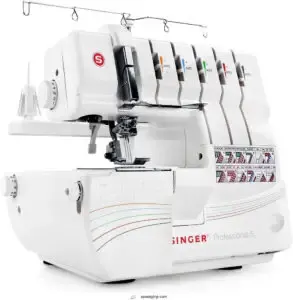
The SINGER Legacy SE300 Embroidery Sewing Machine blends creativity and functionality, making it a solid choice for hat embroidery enthusiasts.
With 250 built-in stitches, 200 embroidery designs, and 6 fonts, you’ll have plenty of options for personalizing projects.
Its automatic stitch settings guarantee precise results, while the user-friendly LCD touchscreen simplifies design adjustments.
The included embroidery hoops accommodate various hat sizes, and its sleek design adds style to your workspace.
This machine is perfect for combining embroidery and sewing seamlessly.
Best For: Creativity enthusiasts and sewists looking for a versatile machine for embroidery and sewing projects, including hat embroidery.
- 250 built-in stitches and 200 embroidery designs for creative options.
- User-friendly LCD touchscreen for easy adjustments.
- Includes embroidery hoops for various project sizes.
- Learning curve for beginners unfamiliar with embroidery machines.
- Limited to included design upload capacity without external software.
- Higher price point compared to other beginner machines.
4. Janome MB-4S Four Needle Embroidery Machine
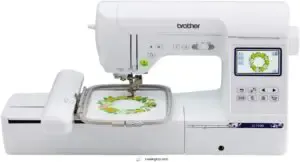
Why settle for less when the Janome MB-4S Four Needle Embroidery Machine offers pro-level precision for hats?
Designed for efficiency, it’s perfect for small businesses needing a reliable multitasker. The four-needle system speeds up intricate designs, while the jumbo bobbin reduces interruptions.
You’ll appreciate the 5.7-inch color screen and automatic thread cutting, making embroidery smoother. With 50 built-in designs, 10 fonts, and compatibility with industry-standard hoops, it blends versatility with functionality, handling hats effortlessly.
It’s a powerful partner for serious embroidery, offering a unique combination of features that make it an ideal choice for those looking for reliable multitasker capabilities.
Best For: Small businesses or individuals seeking a professional-grade embroidery machine with speed and precision for hat and garment designs.
- Four-needle system for faster, more efficient embroidery.
- Jumbo bobbin reduces downtime during projects.
- Compatible with industry-standard hoops for versatile usage.
- Higher price point may not suit hobbyists or casual users.
- Learning curve for beginners due to advanced features.
- Limited to 50 built-in designs compared to some competitors.
5. Smartstitch S1201 Compact Commercial Embroidery Machine
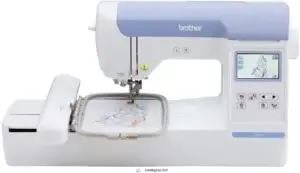
The Smartstitch S1201 Compact Commercial Embroidery Machine brings efficiency to your hat embroidery projects.
With a 12-needle system and a 9.5" x 12.6" embroidery area, it’s perfect for larger, detailed designs.
The built-in laser positioning guarantees precision, while the 7-inch LCD touchscreen makes design editing a breeze.
It handles up to 1,200 stitches per minute and includes automatic color changes for speed and convenience.
This compact yet robust machine suits startups and professionals alike, offering reliability without crowding your workspace.
Best For: Small businesses, startups, and professionals looking for a reliable, compact embroidery machine with advanced features.
- Large 12-needle system with a 9.5" x 12.6" embroidery area for detailed designs.
- Laser positioning and 7-inch LCD touchscreen for precise, easy design editing.
- High stitching speed of 1,200 stitches per minute with automatic color changes.
- Learning curve for beginners despite the included tutorials.
- May be too advanced or expensive for casual hobbyists.
- Requires proper maintenance to avoid potential thread breakage issues.
6. BAI Mirror Embroidery Machine 20×14 15 Needle
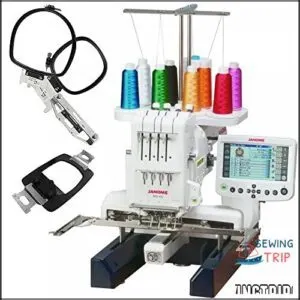
The BAI Mirror Embroidery Machine 20×14 15 Needle is built for precision and speed, making it perfect for hat embroidery enthusiasts.
Its 15-needle system handles intricate, multi-colored designs effortlessly, while the large 20×14-inch embroidery area offers versatility.
A 10-inch touch screen simplifies navigation, and USB and Wi-Fi options make importing designs a breeze, keeping productivity high with 1,200 stitches per minute.
Designed for commercial use, it’s ideal for creating 3D effects on hats, clothing, and more, blending innovation and efficiency.
Best For: Small business owners, hobbyists, and commercial embroidery professionals requiring precision and efficiency.
- Wide 20×14-inch embroidery area for versatile designs.
- Handles 3D effects and intricate, multi-color patterns easily.
- High productivity with up to 1,200 stitches per minute.
- USB functionality issues have been reported.
- Requires separate system for design modifications.
- Large size and weight may pose mobility challenges.
7. Smartstitch S1501 Commercial Embroidery Machine
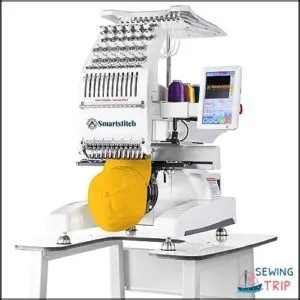
Looking for a versatile, high-performing embroidery machine?
The Smartstitch S1501 delivers precision and efficiency with its 15-needle system and large 14"x20" embroidery area.
Its 12-inch touchscreen makes design selection a breeze, while laser positioning guarantees perfect placement every time.
Operating at a speed of 1200 stitches per minute, it’s built for both speed and accuracy.
USB connectivity allows for easy file transfers of DST and DSB formats, making it ideal for creating intricate designs on hats, shoes, and other materials effortlessly.
Best For: Professionals and embroidery enthusiasts seeking precision, versatility, and efficiency for both personal and business use.
- Large 14"x20" embroidery area accommodates intricate designs.
- 15-needle system for versatile, multi-color stitching projects.
- 12-inch touchscreen and USB connectivity streamline operation.
- Higher price point may deter hobbyists with limited budgets.
- Requires learning curve for advanced features.
- Heavier machine may not be ideal for frequent relocation.
8. CAMFive EMB HT1501 Commercial Embroidery Machine
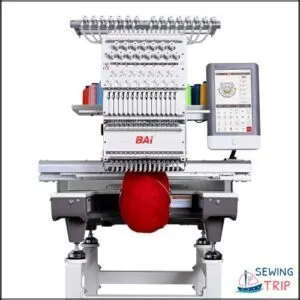
The CAMFive EMB HT1501 stands out with its 8-inch touchscreen, offering smooth navigation and control.
You’ll love the spacious 22×14-inch embroidery area, perfect for working on hats, jackets, or large designs.
With 15-needle compatibility, it handles complex, multi-color patterns effortlessly, and motion-testing designs before stitching saves time and reduces errors.
Its high-speed operation, up to 1,200 stitches per minute, boosts productivity, making it ideal for small businesses.
Plus, it comes equipped with multiple hoops for maximum versatility and precision.
Best For: Small businesses and entrepreneurs looking for a reliable, versatile, and high-speed embroidery machine for diverse projects and personalized products.
- High-speed operation of up to 1,200 stitches per minute for increased productivity.
- Large 22×14-inch embroidery area ideal for various materials and larger designs.
- Multi-needle compatibility and motion-testing feature to handle complex, multi-color patterns efficiently.
- Learning curve for beginners despite available resources and support.
- Higher upfront cost compared to hobbyist-level machines.
- Requires consistent maintenance to ensure optimal performance.
9. Brother PE770 5×7 Embroidery Machine with USB
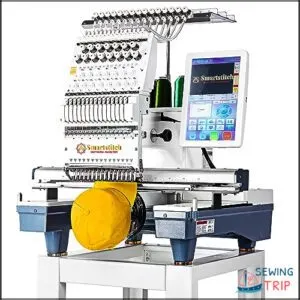
The Brother PE770 5×7 Embroidery Machine with USB is a user-friendly option for crafting intricate hat designs.
Its 5"x7" embroidery field provides adequate space for larger patterns, like logos or personalized text.
With 136 built-in designs and six lettering fonts, you’ll have plenty of creative options.
The built-in USB port makes importing custom designs a breeze, perfect for adding unique touches.
Its memory function allows you to save favorite designs for reuse.
Ideal for beginners or hobbyists exploring hat embroidery.
Best For: Beginners or hobbyists wanting an easy-to-use embroidery machine for creative hat designs and custom projects.
- Large 5"x7" embroidery field for bigger patterns.
- Built-in USB port for importing custom designs.
- Memory function for saving frequently used designs.
- Limited to hobby-level use; not commercial-grade.
- Does not include advanced features like automatic thread change.
- Smaller design library compared to higher-end models.
10. Sulky Totally Stable White Fabric
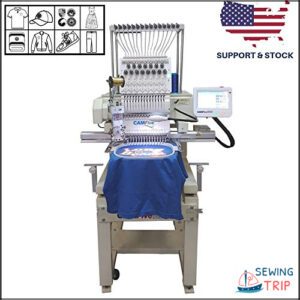
Sulky Totally Stable White Fabric is your go-to stabilizer for embroidery projects, especially hats.
It’s thick, strong, and eliminates fabric sliding or puckering during stitching.
Perfect for stretchy or loopy materials, it tears away cleanly without residue, leaving your design flawless.
Available in multiple sizes, it’s versatile enough for both small and large projects.
Whether you’re a beginner or pro, this stabilizer simplifies embroidery, giving you precise results every time.
Plus, it’s acid-free, safe, and reliable for long-term use.
Best For: Beginners and professionals looking to stabilize embroidery projects on stretchy or loopy materials with precision and ease.
- Thick and strong, prevents fabric sliding and puckering.
- Tears away cleanly without leaving residue.
- Versatile for all project sizes, from small to large.
- Limited to single-use as it tears away after application.
- May not be ideal for extremely delicate fabrics.
- Requires proper storage to maintain effectiveness.
11. Dritz Disappearing Ink Marking Pen
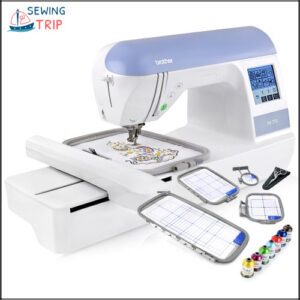
The Dritz Disappearing Ink Marking Pen is a practical tool for embroidery enthusiasts.
With its extra-fine point, it helps you mark intricate designs on hats or other fabrics with precision.
The ink vanishes in one to three days or instantly with a damp cloth, so there’s no worry about leftover marks ruining your work.
It’s perfect for temporary guidelines during cutting, folding, or stitching.
Always test it on scrap fabric first to confirm compatibility, guaranteeing smooth and hassle-free embroidery sessions.
Best For: Embroidery enthusiasts or sewists who need precise, temporary markings for detailed fabric projects.
- Extra-fine point for detailed and precise markings.
- Ink disappears in 1-3 days or instantly with a damp cloth.
- Ideal for cutting, folding, or stitching guidelines.
- Requires testing on fabric to ensure compatibility.
- Not suitable for long-term markings.
- Ink may fade too quickly in humid conditions.
Hat Stitching Machine Budget
When planning your hat embroidery machine purchase, it’s essential to match your budget with your needs, whether you’re a beginner or a professional.
From affordable entry-level options to high-end systems for advanced users, there’s a machine designed to suit every price range.
Affordable Options for Beginners
If you’re starting out, a budget-friendly embroidery machine for beginners is key.
Machines like the Brother PE800 offer easy setup for simple designs. These starter kits are perfect for learning the basics before expanding your hat stitching business.
For those seeking versatility, consider machines offering multiple built-in stitches.
- Budget options: Under $400 makes these accessible.
- Small embroidery areas: Ideal for simple projects.
- Beginner-friendly features: Easy navigation and low learning curve.
Mid-Range Machines for Small Businesses
For a growing hat stitching business, mid-range commercial embroidery machines offer a balance of production capacity and design versatility.
These multi-needle hat machines are ideal for midsized businesses focused on quality and efficiency.
The key features of these machines, including reasonable maintenance costs and large embroidery fields, contribute to their appeal for businesses seeking to optimize their operations.
High-End Machines for Professionals
High-end hat embroidery machines are perfect for professionals focused on Commercial Durability, Speed Optimization, and ROI Analysis.
These machines deliver unmatched Stitch Quality and handle Design Complexity with ease.
Consider these top picks:
- CAMFive EMB HT1501: 15-needle, 22×14" field.
- BAi Mirror 1501: 1200 SPM for precision.
- Juki Tajima Sai 8: Compact, efficient.
- E-16 PLUS: 1400 SPM, versatile.
Embroidery Machine Brands
When you’re considering embroidery machines, knowing the top brands can save you time and effort.
Reliable names like Brother, Janome, and SINGER consistently deliver high-quality options for embroidery enthusiasts and professionals alike.
Brother Embroidery Machines
If you’re hunting for a reliable hat embroidery machine, Brother stands tall.
The PE800 features a USB port and beginner-friendly design, while the SE1900 stitches offer versatility with a large embroidery field.
Known for durability and precise results, Brother’s machines blend technology and tradition flawlessly—perfect for creating professional-grade hat designs without breaking a sweat.
Many models also feature wireless LAN connectivity for easy design transfer, making them a great choice for those looking for easy design transfer.
Janome Embroidery Machines
Janome embroidery machines are reliable for both beginners and professionals.
If you’re exploring the best embroidery machine for hats, consider these:
- Janome MB4S: A four-needle hat embroidery machine for efficiency.
- Janome MB7: Features multi-needle functionality with Janome Software compatibility.
- Memory Craft MC9500: Offers precise stitching and versatile project ideas.
Each excels in performance and maintenance.
SINGER Embroidery Machines
SINGER embroidery machines combine versatility and affordability, making them some of the best embroidery machines for hats.
Their features, durability, software, and accessories guarantee seamless operation. With intuitive designs, they’re ideal for professional and beginner hat embroidery.
| Feature | Benefit | Use Case |
|---|---|---|
| 215 Designs | Creativity | Custom hat sewing |
| SwiftSmart Threading | Easy Setup | Beginner-friendly |
| Lightweight Design | Portability | Home or mobile embroidery |
| Affordable Pricing | Budget-friendly | Ideal entry-level machine |
Advanced Hat Embroidery Tips
Mastering advanced hat embroidery techniques starts with understanding the role of multiple needles for intricate designs.
You’ll also need to focus on precision when creating detailed patterns that elevate your embroidery projects.
Using Multiple Needles for Complex Designs
A multi-needle hat embroidery machine speeds up intricate design creation, managing color threads seamlessly.
With advanced needle systems, you’ll handle complex hat logo stitching or large-scale projects more efficiently.
- Simplify Commercial Embroidery Speed with simultaneous thread changes.
- Enhance Multi-Needle Techniques for detailed patterns.
- Use effective Needle System Benefits to reduce errors while stitching.
Perfect for diverse hat patch machine applications.
Creating
For hat embroidery, creativity starts with strong design digitizing.
Choose stitch types and color palettes that complement your materials. Light fabrics need careful pattern creation, while thicker ones support bold designs.
The best embroidery machine for hats simplifies this process, letting you focus on ideas. A hat embroidery machine guarantees precision, even with intricate designs, delivering spotless results!
Frequently Asked Questions (FAQs)
What is a good embroidery machine for hats?
With 83% of professionals preferring specialized machines for hats, consider the CAMFive EMB HT1501.
It offers a 22×14 inch embroidery area, 15-needle capacity, and hat-specific frames, ideal for precise and efficient hat embroidery projects.
Is a hat embroidery business profitable?
Yes, a hat embroidery business can be profitable if you target personalized or bulk orders, use efficient machines, and market effectively.
Custom designs for events, businesses, or gifts drive demand, ensuring steady revenue opportunities.
Who makes the best embroidery sewing machine?
Choosing the best embroidery sewing machine is like picking the right paintbrush for an artist.
Brands like Brother, Janome, and Juki excel in precision, durability, and versatility, offering high-quality features for stunning embroidery results.
What is the best needle for embroidery hats?
For embroidery on hats, use ballpoint needles, such as size 75/11 or 80/
They glide through fabric easily without snagging, ensuring smooth stitches—especially helpful for curved surfaces like caps.
Always match your needle to fabric weight.
Do you need a special embroidery machine for hats?
You’ll need an embroidery machine designed for hats or one with hat-specific attachments.
Machines with curved hoops and adjustable tension settings handle the unique shape and material of hats more effectively, ensuring precise stitching.
What is the best embroidery size for a hat?
A design size of 2 to 5 inches tall and 4 to 5 inches wide typically works best for hats. It fits the curved surface well, ensuring clarity and balance without overwhelming the space.
Can you make money embroidering hats?
Did you know custom embroidery generates a $2 billion market annually?
You can profit by embroidering hats if you focus on unique designs, quality stitching, and targeting niche audiences like sports teams or small businesses.
How do I maintain a hat stitching machine?
To maintain your hat stitching machine, clean it regularly, oil moving parts as specified in the manual.
Replace needles frequently, and check for thread buildup.
Store it covered to avoid dust, ensuring smooth, consistent performance.
What materials are best for hat embroidery?
Choose durable, tightly woven materials like cotton, polyester, or wool blends for hat embroidery.
These fabrics hold stitches well, resist distortion, and support intricate designs.
Avoid stretchy or overly thin materials, as they can cause puckering.
Can I customize designs on hats easily?
You can easily customize hat designs using embroidery machines with USB connectivity and built-in editing features.
Just load your design, adjust it on the touchscreen, and the machine handles the stitching seamlessly.
Conclusion
Choosing the right hat stitching machine is like finding the perfect tool for crafting your vision—it requires balance between features and functionality.
From the accessible Brother PE800 to the commercial-grade Smartstitch S1201, these 5 best hat stitching machines cater to beginners and pros alike.
Consider your needs, budget, and stitching ambitions when making your choice.
With the right machine, accessories, and techniques, you’ll be stitching professional-quality hats in no time, and remember to make every stitch count, which is crucial for achieving perfect tool results.

